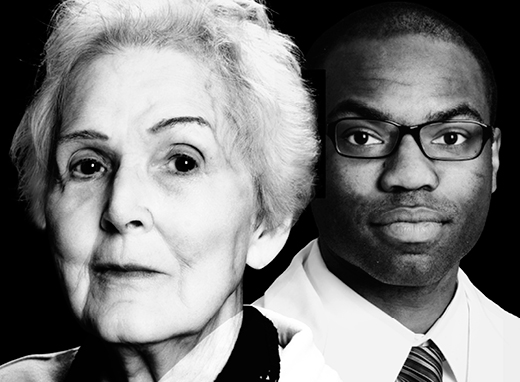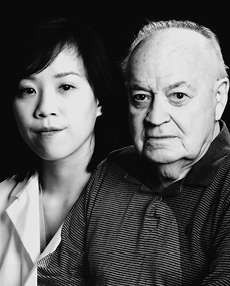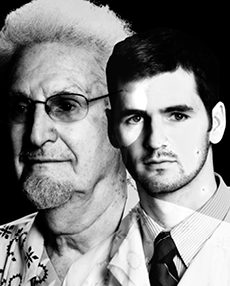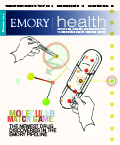The Lens of Aging

*Pictured are Emory medical students who participated in the aging course and residents of Wesley Woods Towers apartments.
by Kay Torrance, Photography by Jack Kearse, and illustrations by Linda Dobson
Emory’s medical school is teaching young doctors what it is like to grow old and how to better care for elderly patients.
The 70-year-old woman enters the exam room in a wheelchair. She recently fell off a stool and hurt her back, she tells Emory geriatrician Manuel Eskildsen.
Through a series of questions, Eskildsen learns that the woman has not fallen before or had balance problems. He decides to order some x-rays just to rule out a broken bone. If the patient were younger, the conversation might end there. But Eskildsen probes further, asking the woman pointed questions about her life. He learns that her spouse died four years ago, and she’s having trouble doing things around her house. She goes to church but doesn’t have much social interaction beyond Sunday. After Eskildsen makes some recommendations to her—getting some short-term in-home help and starting physical therapy—the woman leaves.
Some 140 Emory medical students are carefully listening to this patient’s conversation with her doctor. The “patient” in this scenario is an actor, and she and Eskildsen have just been role-playing a fairly typical encounter between a geriatrician and a senior patient.
“So what do you think?” Eskildsen asks the students after the lights come up in the auditorium.
“If I’m ever old, I want you to be my doctor,” says one student.
“Well thank you. If you are ever old?” Eskildsen responds.
“She’s lost her social support,” volunteers another student.
“Right. It is crucial to ask geriatric patients about family and general social support,” says Eskildsen. “Their answers can make a difference in treatment choices, living arrangements, and end-of-life care.” The discussion turns to whether frailty leads to injury or injury leads to frailty. (Correct answer: both are true.)
These medical students are learning about the process of aging, how to treat geriatric patients, and how to talk about dying—topics that most doctors in practice now didn’t cover when they were in training.
Aging 30 years in one week
In years past, medical schools traditionally offered little instruction about geriatrics and limited contact with patients until the third year. But Emory and other leading medical schools around the country are redefining how future doctors are educated.
Among the changes are new curriculums that are less focused on disease and more centered on patients. Gone are old-school, lecture-based courses. They’ve given way to more engaging, experiential courses and modules on topics such as aging and cardiology, where students learn the science of disease while working with patients to understand firsthand experiences. Today’s best medical schools want to produce not only the best but also the most compassionate doctors.
The students enrolled in the week-long aging module at Emory’s medical school recently watched a patient (actor) age from 50, as she entered menopause, to 80, when she was dying of cancer. They listened to the perspectives of two caregivers, who discussed their loved ones’ conditions, the changing relationship between loved ones and caregivers, and the caregivers’ organizational struggles to manage a dizzying array of doctors and medications. They heard from a 66-year-old man living with advanced prostate cancer who was coping with his own mortality.
What they saw spurred all manner of questions. How receptive are patients to behavior modification? How is the approach of a geriatrician different from that of an internist who sees elderly patients? What happens inside the body to cause pressure sores? What role does obesity play in the physical changes of aging? How much information or questions do you direct toward the patient versus the caregiver?
How does a young medical student experience how a senior feels?The student is outfitted with colored ski goggles (vision changes), an arm brace (decreased strength), and a weighted backpack (weight gain). The student’s legs are tied together to cause trouble walking, and the student is told to walk three feet and open a childproof pill bottle. Emory geriatrician Jonathan Flacker runs this exercise with first-year medical students so they will understand how physical changes in seniors impact their everyday lives. |
|||
Have you ever thought you might be dying?
Emory hospitalist Noble Maleque draws a blue line across the whiteboard. He’s leading a group of eight students in a conversation about death and dying during the final day of the aging module.
“If you could choose how you were going to die, would you want to go suddenly or have up to six months’ notice,” he asks. The students each place a sticky note with their name on the timeline. Four want to die suddenly, and the other four want at least two months.
“Now you are the doctor, and you know that your patient is going to die soon. Should you tell the patient?” Maleque says.
Of course, says one student.
Not quite, Maleque says before recounting a recent clinical experience from real life—no actors this time.
His patient’s T cell count was abysmally low at 2. (A healthy person’s count is typically around 1,000.) AIDS had run its course, and the man was dying, and Maleque gently told him so. The patient later asked a hospital administrator why his doctor told him that he was dying. He had known that his condition was getting worse, but he had no desire to hear his suspected fate.
“But if I’m the doctor, that’s what I’m there for,” the student says. “The patient may not know their treatment choices, including to do nothing, so the patient needs to know if he will die.”
“In that encounter with the patient with AIDS, I felt I had the right intention,” Maleque says, “but I wasn’t right because I didn’t ask him if he wanted to discuss the progression of his condition. I should have addressed the issue before it came up.”
Discussing death with patients is difficult, Maleque acknowledges. “It can be an emotional topic—and that’s good. It’s real life. I still have a hard time with death as a physician,” he says, “and that’s as it should be.”
Maleque is glad to see that Emory’s medical students are getting prepped for such conversations. That was not his own experience in medical school, and the first time he experienced a patient’s death during his residency, he felt inconsolable, he says. “I’m wondering if I had gone through exercises like this how I would have coped.”
These sessions are designed to help students acknowledge their own feelings about death. They are held in a small group format to stimulate intimate conversation and debate, says Emory geriatrician Jonathan Flacker, who leads the aging module along with Eskildsen.
“Students have to come to grips with death and dying before they can help other people through the process,” he says. “It’s still important to treat people when a cure isn’t there.”
Through the patient skits, students see the right and wrong way to have a difficult conversation with a patient. A starting line, such as “Have you ever thought that you might be dying,” can pave the way to a bigger conversation on quality of life weighed against the amount of time left.
Emory medical student Porntawee Aphivantrakul, who went through the aging module last November, came out with a reinforcement to keep the patient’s perspective in mind. “It’s easy to lose sight of that,” she says. “Some people want to display compassion but find it difficult. This taught us the best way to approach patients.”
New technology for understanding older patientsEmory’s medical faculty would like nothing better than to take all the medical students into Wesley Woods’ outpatient clinic to observe geriatric patient exams. But the class of 2014 at 140 in number is the school’s largest so far. Squeezing that many students into the clinic over the course of a week would be impractical. But Emory took a new approach during the aging module. Students were able to follow a different geriatrician each day via Twitter. Each afternoon, a geriatrician tweeted about cases to give students a sense of the variety and scope of the issues that a geriatrician handles daily. |
|||
The silver tsunami
Regardless of the medical specialty chosen by the students from the class of 2014, they most likely will care for geriatric patients. Flacker and other geriatricians refer to the America’s changing demographics as an impending “silver tsunami.” By 2050, those 80 and older will be larger than any other age group. (By contrast, in 1950 the largest age group was children under 4.)
The silver tsunami will demand that today’s medical students know how and why senior patient care differs from other care. But first and foremost, Eskildsen and Flacker want students to understand that aging is not a disease.
“I want them to know what is different about older adults—biologically and physiologically—and approach them differently,” Eskildsen says. “That awareness is the thing. They will get more clinical training later, but planting that seed now that geriatric patients are different will set them on a better course. I hope that we have punctured the myth that just because a doctor sees a lot of older people in his practice, he automatically can be assumed to do a good job of it. Older people are different, and we need to adjust our care.”
Beyond teaching the defining principles of geriatric medicine, Eskildsen and Flacker also would be happy if the module stimulated interest in geriatrics as a career choice among students. There are only 8,000 geriatricians in the country, a number that is not expected to grow substantially.
Things will have to change to attract the best medical graduates to the field, says Flacker, including financing and reimbursement. “We also need to see a change in how people and our society value serving the elderly as a career,” he says.-EH
|
Web Connection: To hear some age-old wisdom from the older residents to the younger doctors, bit.ly/emoryaging. |
||||




